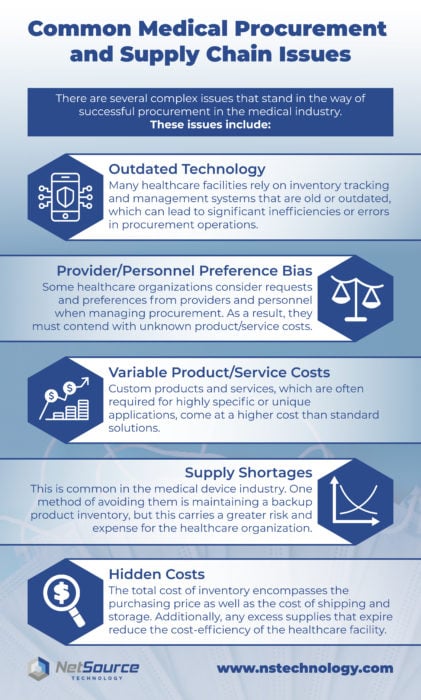
In the medical industry, developments in patient treatment technologies and techniques have long overshadowed the backend issues industry professionals continue to face. As doctors and nurses adopt new tools to help them diagnose and treat the healthcare facility’s patients, the facility’s procurement team must ensure the inventory continues to satisfy the demand. However, they must tackle and overcome many challenges to fulfill this goal, including out of stock or obsolete items and decreasing budgets.
The following article focuses on medical device component procurement, outlining what it encompasses, common issues, and steps to ensure successful procurement in the healthcare supply chain.
What Is Healthcare Procurement?
Healthcare procurement refers to the healthcare supply chain process that allows medical industry professionals to identify, select, and acquire the materials, products, and services required to accommodate their current needs. It can be further divided into two subcategories: direct procurement and indirect procurement. Direct procurement involves sourcing and acquiring what is needed for patient diagnosis and treatment operations (e.g., testing equipment and surgical tools), while indirect procurement involves sourcing and acquiring what is needed to support general facility operations (e.g., office supplies and cleaning materials). By establishing and managing a solid supply chain, the procurement team is better able to ensure they can source and acquire the products and services they need when they need them.
Common Medical Procurement and Supply Chain Issues
 There are several complex issues that stand in the way of successful procurement in the medical industry. These issues include:
There are several complex issues that stand in the way of successful procurement in the medical industry. These issues include:
- Outdated technology. Many healthcare facilities rely on inventory tracking and management systems that are old or outdated, which can lead to significant inefficiencies or errors in procurement operations.
- Provider/personnel preference bias. Some healthcare organizations take into account requests and preferences from providers and personnel when managing procurement. As a result, they must contend with unknown product/service costs.
- Variable product/service costs. Custom products and services, which are often required for highly specific or unique applications, come at a higher cost than standard solutions.
- Supply shortages. Product shortages are common in the medical device industry. When they occur, healthcare organizations are often forced to satisfy themselves with more expensive or less effective alternatives. One method of avoiding them is maintaining a backup product inventory, but this carries a greater risk of products expiring and a larger inventory management cost.
- Hidden costs. The total cost of inventory encompasses more than the purchasing price. It also includes the cost of shipping and storage. Additionally, any excess supplies that expire reduce the overall cost-efficiency of the healthcare facility.
Steps to Successful Procurement in the Medical Supply Chain
By establishing a strategy that helps them navigate the challenges of procurement, medical organizations can better develop and manage their supply chains. The four steps to creating this strategy are:
- Data Gathering. When a medical sales representative approaches a healthcare facility, they typically have all of the information they need to help them make and close a sale available, such as product datasheets, studies and white papers, MSDS documents, pricing plans, and supplier contact information. This gathered information helps the facility’s value analysis team (VAT)—i.e., the procurement team—evaluate whether the product/service solution fulfills their clinical needs.
- Negotiating. The primary goals of healthcare facilities are satisfying their physicians, patients, and bottom lines. As a result, the product/service solutions they invest in must meet the needs of their personnel and patients at a competitive price. Procurement professionals should evaluate how a particular solution stands up to alternative solutions with regard to effectiveness and price point. If needed, they can negotiate with suppliers to achieve a better rate.
- Testing and Trialing. Setting up test and trial periods allows healthcare facilities to try out a product or service and see whether personnel and/or patients like it.
- Resolving. After evaluating the product/service information presented by a sales representative, pricing plans, and data gathered from the test/trial periods, the healthcare facility’s procurement team should be able to determine whether the product/service meets their clinical and financial needs. If it does, they can allocate budget funds towards investing in it.
Hard-To-Find Medical Components for Medical Device Manufacturers
Our expertise in sourcing obsolete, end of life components is pivotal to both contract manufacturers and OEMs who manufacture these essential devices for the medical industry. The components for medical devices that we can procure includes the following:
- Pressure Sensors

- Cable assemblies
- Camera modules
- Sensors + lenses
- Capacitors
- Connectors

- Inductors
- LCD panels
- LED indicators
- Power supplies
- Push button components
- Relays
- Resistors
- RF components
- Switches
- Transistors
- Optoelectronics
Many of these components can be found, along with more information, at our online shop.
Supply Chain Optimization & Component Sourcing from NetSource Technologies
Healthcare organizations face many challenges in procuring the medical products and components they need for their operations. Partnering with an experienced and knowledgeable procurement and supply chain partner can help them overcome these challenges.
At NetSource Technology, we offer complete procurement solutions, from sourcing to support. Equipped with years of industry experience, extensive product knowledge, a large product inventory, and a worldwide network of suppliers, we serve as a premier procurement and supply chain partner for customers across a wide range of industries. We source and stock current and obsolete parts from a variety of reputable manufacturers, including end-of-life, hard-to-find, and highly allocated parts. If your healthcare facility needs procurement and supply chain management assistance, we’re here to help.
To learn more about how we serve the medical industry, check out our medical page. To discuss your requirements with one of our experts, request a quote.




